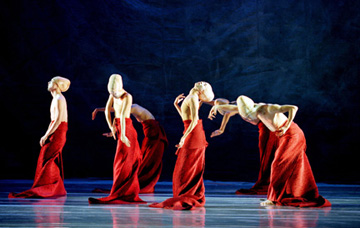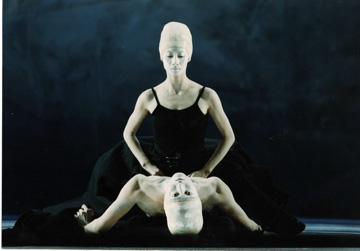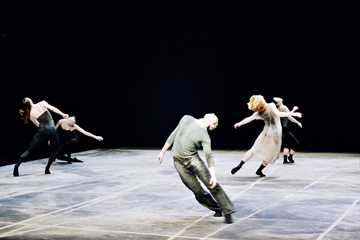“Rite of Spring” and "Folding"
Shen Wei Dance Arts
Eisenhower Theater
The John F. Kennedy Center for the Performing Arts
Washington, DC
October 21, 2005
by Alexandra Tomalonis
copyright ©2005 by Alexandra Tomalonis
 Shen Wei’s dances are rich, dreamy, and cold as glaciers. Each dancer is an island, even when dancing chest to chest with another. In his “Rite of Spring” (2003), the dancers move through the two-piano version of Stravinsky’s landmark score like gymnasts engaged in games of solo chess. In “Folding (2001), dancers scurry and glide ever so slowly, high priests of an alien galaxy, skirting each other as they move about the stage. Paradoxically, both dances invoke associations with ritual as they avoid enacting them. This paradox is one of the reasons Shen’s dances are so exciting. We may not know what ritual the dancers are, or are not, enacting, but we know that they do. The dances also have a strange and wondrous beauty. Shen is a painter, and his dances are moving paintings, three-dimensional visual experiences.
Shen Wei’s dances are rich, dreamy, and cold as glaciers. Each dancer is an island, even when dancing chest to chest with another. In his “Rite of Spring” (2003), the dancers move through the two-piano version of Stravinsky’s landmark score like gymnasts engaged in games of solo chess. In “Folding (2001), dancers scurry and glide ever so slowly, high priests of an alien galaxy, skirting each other as they move about the stage. Paradoxically, both dances invoke associations with ritual as they avoid enacting them. This paradox is one of the reasons Shen’s dances are so exciting. We may not know what ritual the dancers are, or are not, enacting, but we know that they do. The dances also have a strange and wondrous beauty. Shen is a painter, and his dances are moving paintings, three-dimensional visual experiences.
“Folding” is a variation on some of the ideas Shen presented in “Near the Terrace,” which his company presented here a few years ago: repetition, a distortion of conventional beauty that challenge our ideas of beauty, an extremely slow pace, and simple, serene movements punctuated by occasional bursts of activity. In “Folding’s” case, each dancer suddenly and emphatically falls out of his or her glide to a cross-legged sitting position, as though each is a table, one leg of which has collapsed; later, fingers wiggle, as though enjoying a few  seconds of freedom. The first group of dancers is dressed in skirts made from yards and yards of deep red cloth. They’re bare-chested (the women with flesh-toned cloth wrapped around their torsos) and their heads are thrust backwards, their arms carried like flippers. It must be an excruciating position to maintain. A second group (or, more likely, the same dancers after changing costumes; it’s a small troupe) is dressed in black skirts. While the Red Skirts move alone, always in small clusters like schools of fish, the Black Skirts are paired: one dancer stands on another’s shoulders; another pair will seem joined at the waist, the one in front bent backward. Red and Black Skirts share the stage, but do not interact.
seconds of freedom. The first group of dancers is dressed in skirts made from yards and yards of deep red cloth. They’re bare-chested (the women with flesh-toned cloth wrapped around their torsos) and their heads are thrust backwards, their arms carried like flippers. It must be an excruciating position to maintain. A second group (or, more likely, the same dancers after changing costumes; it’s a small troupe) is dressed in black skirts. While the Red Skirts move alone, always in small clusters like schools of fish, the Black Skirts are paired: one dancer stands on another’s shoulders; another pair will seem joined at the waist, the one in front bent backward. Red and Black Skirts share the stage, but do not interact.
All of the dancers wear headpieces that make them look like alien hominoid beings fresh from an episode of “Star Trek”—or Egyptian priests or a strange, hydrocephalic race. There’s a dangling pendant that appears and reappears, endlessly flying in a circle, which has no obvious relationship to the dancers but may be a measure of time. At the end, the backcloth—a painting of fish that seems both ancient and contemporary—seems to turn into a rich black velvet, and the dancers leave, walking up a set of stairs that is invisible in the darkness. The effect is gorgeously eerie, a mood that has been established by the music (mostly by John Tavener, with patches of Tibetan chants.)
 “Rite of Spring” doesn’t strive for beauty, though there’s an attractive play of symmetry and anti-symmetry here as well. The stage floor is a huge painting, with lines and circles and squiggles and smears. The dancers’ costumes—casual garb—echo its patterns. The dancers enter one by one, each taking his or her place in the dancing space without reference to the others. It’s an abstract, often deeply musical, reading of the score, and the movement vcabulary is mostly modern dance, with borrowings from gymnastics—lots of scissors moves, then kind of thing male gymnasts do on a balance beam. It’s exciting to watch, but there’s no catharsis; the dance just ends when the music does. There was one moment when the stsge cleared, leaving a woman alone, but she was no chosen maiden; it was a tease. I found "Rite" an interesting exercise, but wasn’t sure whether Shen chose this approach because the libretto of “Sacre” is inscrutable to him—as trying to set a dance to music from Chinese opera would be to nearly every American choreographer, say—or if it is worthwhile to respond to such powerful music merely as patterns of sound.
“Rite of Spring” doesn’t strive for beauty, though there’s an attractive play of symmetry and anti-symmetry here as well. The stage floor is a huge painting, with lines and circles and squiggles and smears. The dancers’ costumes—casual garb—echo its patterns. The dancers enter one by one, each taking his or her place in the dancing space without reference to the others. It’s an abstract, often deeply musical, reading of the score, and the movement vcabulary is mostly modern dance, with borrowings from gymnastics—lots of scissors moves, then kind of thing male gymnasts do on a balance beam. It’s exciting to watch, but there’s no catharsis; the dance just ends when the music does. There was one moment when the stsge cleared, leaving a woman alone, but she was no chosen maiden; it was a tease. I found "Rite" an interesting exercise, but wasn’t sure whether Shen chose this approach because the libretto of “Sacre” is inscrutable to him—as trying to set a dance to music from Chinese opera would be to nearly every American choreographer, say—or if it is worthwhile to respond to such powerful music merely as patterns of sound.
There are precious few choreographers working today in any genre whose work is as confident as Shen’s. There’s no hesitancy, no missteps. His works are of a piece, and perfect for what they are. Even the experiments, like "Rite of Spring," are thoroughly thought through and polished, and their strange perfection gives them an emotional resonance that simpler, more obvious dances often lack.
Volume 3, No. 39
October 24, 2005
copyright
©2005 Alexandra Tomalonis
www.danceviewtimes.com
|
|